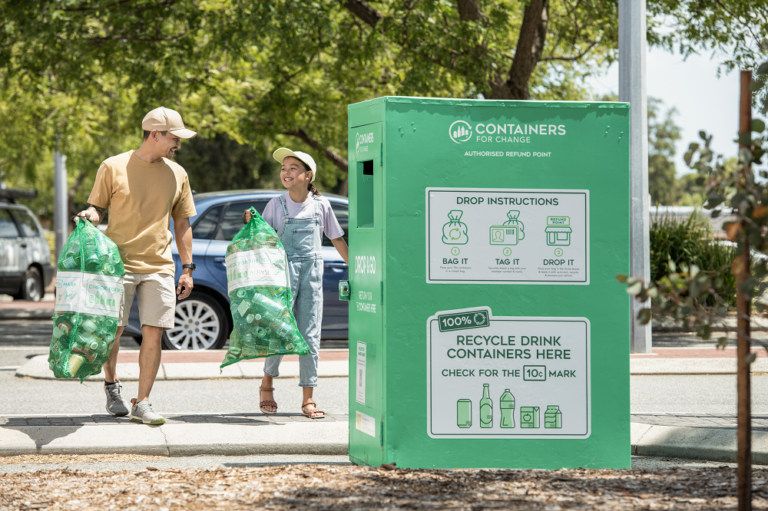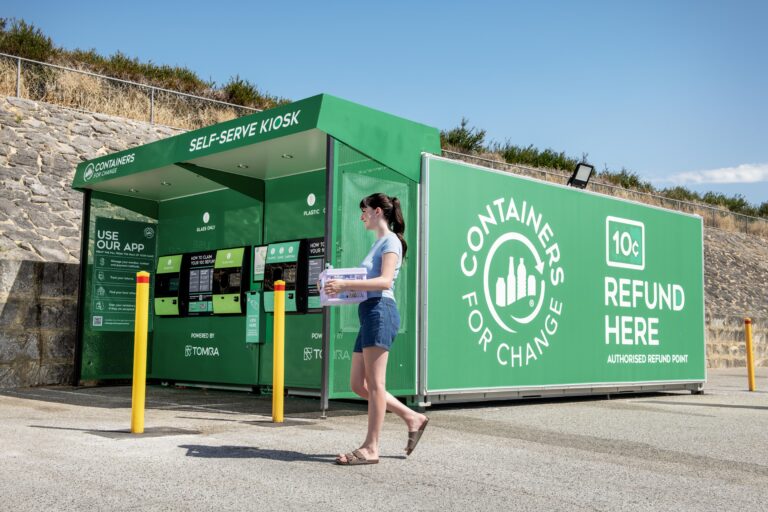A Refund Point (RP) is defined as a physical location where customers can bring their containers to receive a refund.
In WA, the Containers for Change network has a diverse range of RPs.
These RPs can generally be separated in four categories:
- Depots.
- Drop & Go stations (Bag drops).
- Self-serve Kiosks (RVM).
- Pop-up depots
Depots
A depot is a permanent structure where a customer can bring their containers, get them counted onsite and receive an immediate refund, either in cash (note: cash might not be available at all Refund Points) or by bank transfer/PayPal with your Member number. (See Finance and Payment for more info about payment methods)
A depot is also generally an aggregation point. This is where the logistic infrastructure and containers are stored and where the logistic partners come to pick up the containers. Most depots allow for both customers and logistic activities.
Depots can be very different in their size and organisation. Some offer a drive-thru system, while others allow people to walk in. They can also use different methods of sorting containers (See Counting and Sorting Containers) such as hand-counting or counting machines.
Drop & Go stations (Bag drops)
Drop & Go stations are secure facilities (that may be attended or unattended by a staff member) where customers can drop off eligible containers, bagged and labelled with a member number, to be counted and aggregated by the Refund Point Operator (RPO) later at their designated aggregation point.
The RPO is responsible for aggregating the bags, sorting, counting, and entering customer returns into the Point of Sale (POS) system within a set time (E.G., three business days or otherwise agreed).
There are different types of drop & go stations:
- Drop & Go’s at depots can offer a desirable service for customers who have large volumes or are time poor. It enables them to drop-off their containers to the secure depot and leave the site with minimum delay.
drop & Go’s that are accessible after hours (on an operator’s fence line for example) are a great way to provide customers with an option outside of the Refund Point’s business hours. - A standalone Drop & Go can help RPOs reach out to customers in other areas, particularly if they are already servicing customers in the area (E.G., Commercial venues or schools).
Drop & Go stations can be of different sizes and shapes but must comply with WARRRL’s specifications for infrastructure and signage requirements as a similar design and signage throughout the network helps customers recognise the structure as an approved refund point.

Safety must always be a priority. All Drop & Go stations must display a “danger” sign and phone number for people to call after hours.
The containers must be picked up regularly by the operator in charge of the Drop & Go station, brought back to the depot or aggregation point, sorted, and counted ideally in less than:
- Three business days for metropolitan areas.
- Five business days for regional areas.
- Seven business days for rural areas.
Once the transaction is processed on the POS system by the RPO, the refund amount is automatically sent to the customer (or their chosen charity) via bank transfer or PayPal.
Self-serve kiosks (RVM)
Self-serve Kiosks are automated Refund Points that use technology to recognise and count eligible containers inserted into the machine. There are several suppliers of Self-serve Kiosks in the market and RPOs will be responsible for the procurement of (purchase or lease), and ongoing maintenance of the Self-serve Kiosks.
All Self-serve Kiosks must offer the refund to be paid to the customer or a nominated charity by a member number or via cash/cash equivalent.
It is a requirement that all Self-serve Kiosks are configured to ensure they can interface with the WARRRL IT platform and all costs associated with this configuration will be the responsibility of the RPO.
RPOs of Self-serve Kiosks may also wish to enter commercial arrangements with retailers to enable the issuance of cash-equivalent vouchers, redeemable at those retailers. However, any such cash equivalent arrangements must have the prior approval of WARRRL and WARRRL itself will not be a party to these arrangements.
The RPO will be responsible for the transport and aggregation of the collected containers to the RPO’s designated aggregation point.
Pop-up depots
Pop-up depots are Refund Points with temporary infrastructure (E.G., cages or trailers) that operate on a scheduled timetable at fixed locations.
Containers are counted and recorded on site via the POS system and customers provided with a refund via cash or their member number (Scheme ID). The RPO is responsible for the transport and aggregation of the collected containers to the RPO’s designated aggregation point.
The operation of a Pop-up depot is popular in regional areas where the establishment of a depot is not a viable solution. They offer a local redemption option for smaller regional towns and are sometimes the only recycling system in remote areas.
Some Pop-up depots are also established in the Perth metropolitan area. They can be a great way to boost container volume and make the RPO known within their local community. Pop-up depots can be utilised at farmer’s market, shopping centres, or sports grounds for example.
Aggregation points
In addition to these four types of Refund Points, some RPOs have an “aggregation only site”. This is a site where Containers for Change tasks such as sorting, storing, logistics, and pick-up can be organised, but where the public is not allowed.
Further information
The four different ways of returning containers allows both RPOs and customers flexibility and options in their recycling journey.
If an RPO is interested in opening a new Refund Point, they should visit Setting up a new Refund Point or talk with their regional manager.
